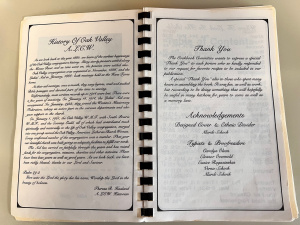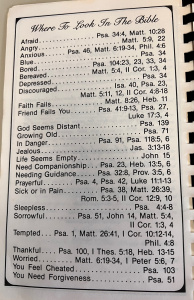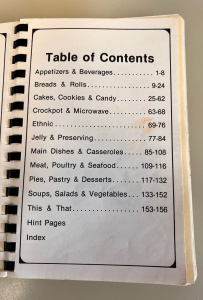First, a description of the structure and content of the The Joy of Sharing:
Publishing Details
The copyright page states that the cookbook has been “published and printed by Cookbooks by Morris Press” based in Kearney, Nebraska. This publisher remains an ongoing concern: https://www.morriscookbooks.com/, and the banner on its website proudly proclaims its status as “The Nation’s #1 Cookbook Publisher.” Morris Press Cookbooks offers a template or “starter kit” to guide the process, now available in hard copy or PDF. Many of the features included in The Joy of Sharing (1985) reflect the process Morris Press continues to recommend today, including cover and dividing page art, personal pages, and cooking hints, like “Meat Cuts and How to Cook Them” for beef, veal, pork, and lamb (though I can find recipes for only beef and pork in this cookbook).
A.L.C.W.
The cookbook proper opens with a dedication to the members of the Oak Valley American Lutheran Church Women (A.L.C.W.) and a note regarding its purpose: “It is in commemoration of the Oak Valley Lutheran Church Centennial that this book is published: 1886-1986.”

On the next two facing pages, a history of the A.L.C.W. by the group’s historian, Theresa R. Haaland (a narrative worthy of a separate forthcoming post), and a thank you to the contributors and acknowledgements of Cookbook Committee members’ roles. The Committee comprises six members: Carolyn Olson, Eleanor Overnold, Eunice Ragazinskas, Verna Shock, and Mardi Schock. All are listed as “Typists & Proofreaders” and Mardi Schock is also listed as the designer of the cover and the divider for the “Ethnic” section. More information about the Cookbook Committee members is forthcoming.

Customization
The following page provides an example of the personal pages Morris Press offers for groups to customize their cookbook. It seems fitting that in a Lutheran church cookbook, a denomination that foregrounds the importance of biblical text, the first personal page offers advice for “Where To Look In The Bible” for emotional guidance. When “Blue,” the reader is encouraged to consult Psalm 34; when “Life Seems Empty,” John 15; when “You Feel Cheated,” Psalm 103; and when “You Need Forgiveness,” Psalm 51. Interestingly, only two of the twenty-six emotional stances seem positive, such as “Thankful” and “Prayerful.” Whether this suggests something about emotional life on the prairie, when the group recommends turning to scripture for advice, or is a pre-written document provided by Morris Press or another source, I do not know. But I will be sure to ask!

Contents
The next page is a table of contents, listing eleven categories of recipes across 156 pages, followed by unpaginated hint pages and an index. As the picture indicates, the categories indicate contributions that skewed heavily toward sweets, with long sections devoted to “Breads and Rolls”(both sweet and savory), “Cakes, Cookies & Candy,” and “Pies, Pastry & Desserts.” Other sections include sweet treats too, such as “Crockpot & Microwave, “Ethnic,” “Jelly & Preserving,” and “This & That.”

As previously noted, these sections are indicative of the foodways that point to this community’s identity, such as an “ethnic” section devoted to Norwegian and German foods. This section begins with four separate recipes for the Norwegian waffle-like cookie, krumkake, two recipes spelled “krumkake”; two spelled “krumkage.” Germans from Russia are represented with the recipe for fleischkuekle, meat breaded and deep-fried; a quick Google search points to this dish’s popularity in central North Dakota: https://en.wikipedia.org/wiki/Fleischkuekle. Tillie Michalenko, its contributor, spells the dish “Fleish Keikla.”
Additional recipes reflect common ingredients and techniques used in the meat-based diet of rural North Dakota in the 1980s. These include recipes to preserve fruits, vegetables, and fish (“Canned Fish” submitted by Olga I. Gryde, a cousin of my paternal grandfather), as well as mains with inexpensive cuts of meat, like ground beef, canned shrimp (which I cannot find at my local grocery store!), and chicken. The section for dishes made in the microwave and crockpot points to the rise of appliances that make cooking more efficient in the midst of busy lives (e.g. Margaret Harness’s aptly named “Zippy Microwaved Potatoes”).
End Materials
There are twenty pages of hints at the end, all listed as having a copyright of 1983 from Morris Press. Topics include equivalent measurements for common ingredients, like one lemon providing 2 to 3 tablespoons of lemon juice; guides for buying canned goods, vegetables and fruits, as well as identifying types of cheese; lists of calories for ingredients and dishes; and general definitions of cooking terms. For those of us who now cannot cook without a probe thermometer, it is fascinating to note the inclusion of temperature guidance for candy, but not for vegetables, meat, poultry, and fish. Instead, their preparation is indicated by time, method, and oven temperature.

The Joy of Sharing concludes with an index, organized by recipe category, but now in alphabetical order, and at the very end, an order form for additional copies of the book. Verna Schock is listed as the committee contact; each copy is $6.00, with $1.50 for shipping. As a consumer faced with the inflation of 2023, the shipping strikes me as a value!
Many of these sections deserve more explication and contextualization. Stay tuned for more!
This post is part of an ongoing series in which I make and reflect on recipes and the people who contributed them to the 1985 Oak Valley Lutheran Church compiled cookbook, The Joy of Sharing.

